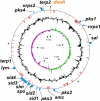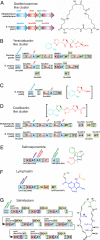Genome sequencing reveals complex secondary metabolome in the marine actinomycete Salinispora tropica
- PMID: 17563368
- PMCID: PMC1965521
- DOI: 10.1073/pnas.0700962104
Genome sequencing reveals complex secondary metabolome in the marine actinomycete Salinispora tropica
Abstract
Recent fermentation studies have identified actinomycetes of the marine-dwelling genus Salinispora as prolific natural product producers. To further evaluate their biosynthetic potential, we sequenced the 5,183,331-bp S. tropica CNB-440 circular genome and analyzed all identifiable secondary natural product gene clusters. Our analysis shows that S. tropica dedicates a large percentage of its genome ( approximately 9.9%) to natural product assembly, which is greater than previous Streptomyces genome sequences as well as other natural product-producing actinomycetes. The S. tropica genome features polyketide synthase systems of every known formally classified family, nonribosomal peptide synthetases, and several hybrid clusters. Although a few clusters appear to encode molecules previously identified in Streptomyces species, the majority of the 17 biosynthetic loci are novel. Specific chemical information about putative and observed natural product molecules is presented and discussed. In addition, our bioinformatic analysis not only was critical for the structure elucidation of the polyene macrolactam salinilactam A, but its structural analysis aided the genome assembly of the highly repetitive slm loci. This study firmly establishes the genus Salinispora as a rich source of drug-like molecules and importantly reveals the powerful interplay between genomic analysis and traditional natural product isolation studies.
Conflict of interest statement
The authors declare no conflict of interest.
Figures



Similar articles
-
Genome-based analysis of type-I polyketide synthase and nonribosomal peptide synthetase gene clusters in a novel strain taxonomically close to the genus Salinispora.J Antibiot (Tokyo). 2015 Dec;68(12):767-70. doi: 10.1038/ja.2015.69. Epub 2015 Jul 1. J Antibiot (Tokyo). 2015. PMID: 26126742 No abstract available.
-
Engineering Salinispora tropica for heterologous expression of natural product biosynthetic gene clusters.Appl Microbiol Biotechnol. 2018 Oct;102(19):8437-8446. doi: 10.1007/s00253-018-9283-z. Epub 2018 Aug 13. Appl Microbiol Biotechnol. 2018. PMID: 30105571 Free PMC article.
-
Bioactivity-guided genome mining reveals the lomaiviticin biosynthetic gene cluster in Salinispora tropica.Chembiochem. 2013 May 27;14(8):955-62. doi: 10.1002/cbic.201300147. Epub 2013 May 3. Chembiochem. 2013. PMID: 23649992 Free PMC article.
-
Interpreting Microbial Biosynthesis in the Genomic Age: Biological and Practical Considerations.Mar Drugs. 2017 Jun 6;15(6):165. doi: 10.3390/md15060165. Mar Drugs. 2017. PMID: 28587290 Free PMC article. Review.
-
Structure and Candidate Biosynthetic Gene Cluster of a Manumycin-Type Metabolite from Salinispora pacifica.J Nat Prod. 2022 Apr 22;85(4):980-986. doi: 10.1021/acs.jnatprod.1c01117. Epub 2022 Mar 9. J Nat Prod. 2022. PMID: 35263117 Free PMC article. Review.
Cited by
-
Iron acquisition in the marine actinomycete genus Salinispora is controlled by the desferrioxamine family of siderophores.FEMS Microbiol Lett. 2012 Oct;335(2):95-103. doi: 10.1111/j.1574-6968.2012.02641.x. Epub 2012 Aug 14. FEMS Microbiol Lett. 2012. PMID: 22812504 Free PMC article.
-
The sequence of a 1.8-mb bacterial linear plasmid reveals a rich evolutionary reservoir of secondary metabolic pathways.Genome Biol Evol. 2010 Jul 12;2:212-24. doi: 10.1093/gbe/evq013. Genome Biol Evol. 2010. PMID: 20624727 Free PMC article.
-
An Unprecedented Number of Cytochrome P450s Are Involved in Secondary Metabolism in Salinispora Species.Microorganisms. 2022 Apr 21;10(5):871. doi: 10.3390/microorganisms10050871. Microorganisms. 2022. PMID: 35630316 Free PMC article.
-
Asymmetric Alkene and Arene Halofunctionalization Reactions in Meroterpenoid Biosynthesis.Synlett. 2018 Mar;29(4):401-409. doi: 10.1055/s-0036-1590919. Epub 2017 Sep 27. Synlett. 2018. PMID: 31031546 Free PMC article.
-
Significant natural product biosynthetic potential of actinorhizal symbionts of the genus frankia, as revealed by comparative genomic and proteomic analyses.Appl Environ Microbiol. 2011 Jun;77(11):3617-25. doi: 10.1128/AEM.00038-11. Epub 2011 Apr 15. Appl Environ Microbiol. 2011. PMID: 21498757 Free PMC article.
References
Publication types
MeSH terms
Substances
Grants and funding
LinkOut - more resources
Full Text Sources
Other Literature Sources
Molecular Biology Databases

